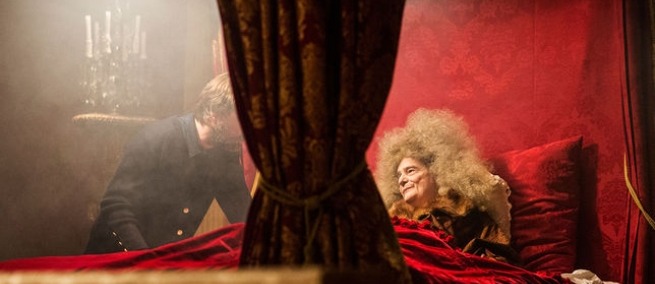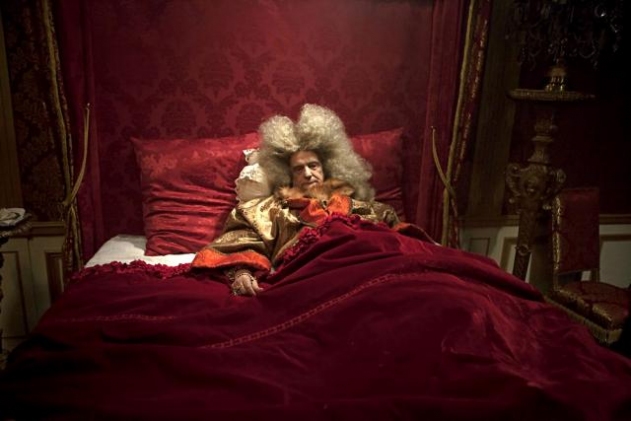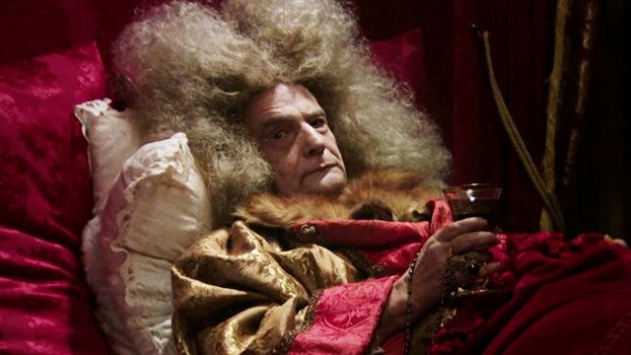
You know as well as I, that medicine is not an exact science. These words are whispered by the courtiers of Louis XIV from outside of his dark bedchamber. The Catalan writer and director Albert Serra’s new film, THE DEATH OF LOUIS XIV, is about the final two weeks of the Sun King’s life. The masterful Jean-Pierre Léaud stars as the dying king whose doctor, surgeon, various specialists, and a quack each try to save their Majesty.
As Louis XIV, even Léaud’s smallest physical movements convey suffering. At the 54th New York Film Festival he said of his role, “I became trapped within an experience that simultaneously was the experience of my own death. It was my own death that was being filmed while I was interpreting Louis XIV’s death.” His facial muscles twitch, eye droops, and mouth curves down. The powder on his face accentuates the cragged lines running across his cheekbones. Yet, he has a beautiful pallor, accentuated by piles of red bed linens and white tufted curls, which frame his face. He lies enshrined in a red curtained king bed.

Though not a documentary, THE DEATH OF LOUIS XIV is based on the official diary of the Health of the King and on the memoirs of the Duke of Saint-Simon, the godson of the King. He had ears and eyes everywhere, as noted by one of the King’s courtiers in the film. It is also based on the notes of another courtier, the Marquis de Dangeau. In 1862, the Librarian of Versailles published The Health of the King, which was a daily record of the King’s health begun in 1652. Dr. Fagon, played in the film by Patrick D’Assumçao, was the last surgeon to keep the record. According to The New York Times, “all [Louis XIV’s] diseases, ailments, indigestions, vapors and disordered fancies are here chronicled in most minute detail, together with a full description of the purges, emetics, tonics, ointments, plasters, lavements and surgical operations which were from time to time administered, used, employed, performed and resorted to, for the purpose of keeping alive, solacing, comforting, cherishing and beautifying the proudest sovereign of his own or almost any other age.”
In the film, a fraternity of doctors and courtiers attend to the Sire’s convalescence. Their luscious wigs and slack faces make them hard to distinguish from one another. They insist that the tools of science will cure the King, though they let a quack from Marseille feed him a mixture of animal bloods. It does nothing.

Despite his state, Louis XIV tries to reign, insisting that it is intelligence which matters–but pain in his leg, fatigue, and an unusually dry mouth distract him. Dr. Fagon rethinks the heavy diet of over-ripe fruit and duck. Yet, he is unconvinced that his Majesty is infected with gangrene. He questions the King’s complaint of leg pain, asking if it isn’t instead a pain from below the kidney. It is clear that the leg smells; the King says he feels too nauseated by its stench to eat.
In 1715, in Versailles, the King died at the age of 72. He died of an embolism in his leg due to cardiac arrhythmia. At the age of 70, he had developed diabetes with gangrenous complications. Serra shows Louis XIV’s body dissected in the same bed in which he slept; his organs held with the same fine linens and silks. His spleen is enlarged. His intestines are twice as long as those of a normal person. A man taking notes with a black quill pen asks when they will cut open the King’s head to examine his brain.
THE DEATH OF LOUIS XIV was shot with three cameras almost entirely in one room. There is a singular outside shot of green hills through a black window grate. There is only one instance of non-diagetic sound, a band playing on the streets for the holiday of St Louis.
Albert Serra’s THE DEATH OF LOUIS XIV premiered at the Cannes Film Festival and is being distributed by The Cinema Guild. It had its U.S. premiere at the 54th New York Film Festival. Film Society of Lincoln Center will be opening the film in March of 2017 and also presenting a retrospective of Jean-Pierre Léaud.